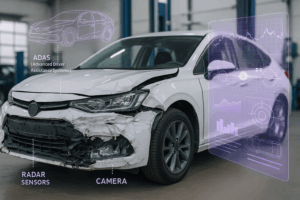The latest figures from the Association of British Insurers (ABI) shows a significant shift in the structure of motor insurance claims. In Q3 2025, insurers paid out £3.0 billion in private motor claims. Remarkably, £1.9 billion of this was spent on repairing vehicles, meaning 64% of all claims cost now relates to repair work.
This raises a key question: why are repairs taking such a dominant share of claims spend?
The answer lies in the powerful combination of rising vehicle complexity and shrinking personal injury claims following recent reforms.
Personal injury reforms: the hidden factor boosting the repair percentage
The Whiplash Reforms fundamentally changed the PI landscape. The introduction of the OIC portal, fixed tariffs and tighter cost rules has led to:
-
fewer cases entering the system
-
lower average payouts
-
dramatically reduced legal cost exposure
As a result, personal injury spend has fallen substantially. This doesn’t mean accidents have stopped happening, only that PI-related costs now represent a much smaller portion of the claims pot.
When one component of the total shrinks, the others appear proportionally larger. So even if repair costs had remained flat, the percentage of the total attributed to repairs would naturally rise simply because PI spend has dropped. This is a critical nuance behind the ABI’s 64% figure.
The complexity of today’s vehicles makes repairs more expensive than ever
Alongside falling PI spend, repair costs themselves have climbed sharply. The ABI notes:
“Today’s cars are packed with advanced electronics, integrated sensors, and smart systems – making even minor repairs more specialised, time-intensive and costly.”
From our work across the UK, we see:
-
ADAS calibration requirements
-
radar, lidar, pedestrian sensors and camera-dependent bumper replacements
-
specialised EV procedures
-
high-value module replacement
-
more complex diagnostics
-
increased repair times, especially EVs
Even relatively minor collisions can involve sophisticated recalibration and specialised labour. In other words: repairs are more expensive at the exact same time that PI claims have become cheaper.
Theft claims add further pressure
The ABI also reports £142 million in theft-related claims in Q3; a reminder that high-tech vehicles, with their advanced modules and high-value components, remain attractive targets for thieves.
Recovered vehicles often require in-depth, technical assessments covering:
-
missing or cloned ECUs
-
compromised keyless systems
-
wiring loom damage
-
tampered ADAS modules
These claims add additional weight to the overall repair and recovery spend.
A paradox for insurers: lower premiums, high costs yet still benefits
 Despite the pressures above, the ABI reports that average premiums fell to £551 in Q3 2025, down £56 year-on-year.
Despite the pressures above, the ABI reports that average premiums fell to £551 in Q3 2025, down £56 year-on-year.
So how are insurers benefiting in a landscape where: repair costs are rising, theft costs remain high, technology is intensifying complexity yet premiums are falling?
1. Reduced personal injury exposure is saving insurers huge amounts
PI claims historically represented the largest, most volatile element of motor claims cost.
Post-reform their volume is down, payouts are lower, legal costs have collapsed, fraud opportunities have reduced.
This has created a more predictable, lower-cost claims environment for insurers. These savings outweigh much of the additional repair cost pressure.
2. Claims cost volatility is lower
With PI now more controlled, insurers operate with lower reserve uncertainty, smoother loss ratios, fewer large, unpredictable settlements.
This makes pricing models more stable and reduces risk margins.
3. Faster, digital-first claim handling improves efficiency
Reforms and the shift towards digital platforms (including our own ecosystem, Swiftcase) help insurers, process claims quicker, reduce overheads, cut cycle times, avoid unnecessary legal escalation. Efficiency equals profitability.
4. Better assessment accuracy lowers long-term repair costs
Insurers partnering with high-quality, tech-enabled assessment providers, like us, see fewer inflated repair estimates, reduced unnecessary replacement, faster decisions, lower total loss leakage, more transparent repair pathways.
This precision helps insurers offset the cost of more complex repairs.
Where Laird fits into this new landscape
The evolving claims environment amplifies the importance of accurate, transparent and technologically advanced assessments.
Laird supports insurers by providing:
Tech-driven triage with Human-in-the-Loop decision-making
Our AI models accelerate early-stage analysis, while experienced engineers ensure safety and technical accuracy.
Deep expertise in EVs, ADAS and modern vehicle systems
As vehicle complexity increases, our engineering team provides the specialist insight needed for cost-effective, technically correct decisions.
Digital collaboration with repairers
Reducing delays, improving transparency and helping avoid inflated repair paths. Exploring total loss avoidance schemes where possible
Evidence-led cost control
Ensuring the correct balance between repair, replace and total loss; critical now that repairs are 64% of total claims spend.
The road ahead
With repair complexity rising and PI spend falling, we’ll continue to see a larger share of the claims pie allocated to repairs. Theft pressures and technological sophistication will add further challenges.
However, insurers are benefiting through lower PI exposure, reduced legal outlay and improved claims predictability and those gains can continue, provided the industry keeps embracing efficiency, accuracy and intelligent digital tools.
At Laird, we’re proud to play a central role in that transformation, helping insurers and repairers navigate rising repair costs with clarity, fairness and precision.

